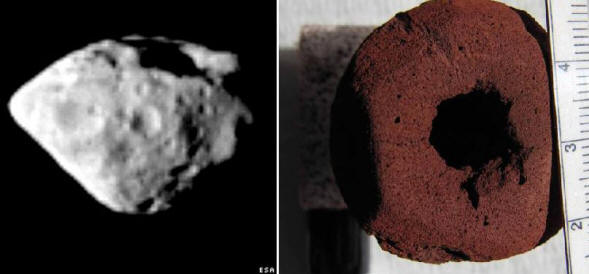An asteroid with an enormous
crater prompts another question of
why it was not destroyed by the
"impact.""Because in the beginning was the plasma."--- Hannes Alfvén in his Nobel Lecture on December 11, 1970.
On March 2, 2004, the European Space Agency (ESA) launched the
Rosetta Cometary Probe on a rendezvous mission with 67 P/Churyumov-Gerasimenko,
a short period comet that will enter perihelion in August of 2015. One year
after launch, Rosetta received a gravity assist from Earth in order to boost its
speed and conserve fuel. In February 2007, Mars kicked-up the space probe's
velocity and swung it back around Earth again, where it was accelerated toward
an encounter with Asteroid 2867 Steins. In November 2009, Rosetta will circle
the Earth for the last time in order to receive its final push into deep space.
In May of 2014, Rosetta will awaken from deep space hibernation and enter orbit
around 67 P/Churyumov-Gerasimenko. The spacecraft will release a science
platform called Philea, which will attempt a soft landing and assess the
cometary nucleus as it begins to generate a coma and tail. Rosetta will be in
orbit around the comet during the entire year of its inward journey, monitoring
Philea and analyzing the coma. The mission will end when the Sun's energy fries
the spacecraft.
2867 Steins is a small, irregular body with a maximum diameter of six
kilometers. Based on information received from the Rosetta OSIRIS imaging
system, a pair of craters was found with a combined diameter equal to more than
20% of the asteroid's volume. Mission specialists are "amazed" that the
2-kilometer "impact site" did not blast Steins into tiny fragments.
According to H. Uwe Keller, the OSIRIS camera team's lead investigator, Steins
is probably shattered throughout its interior because of the shockwaves from
whatever obliterated its parent body eons ago. As conventional theories of
asteroid formation propose, the big craters and the string of seven smaller
craters probably came about when that primordial parent experienced its death
paroxysm.
Current asteroid composition and formation estimates are largely based on the
anomalous cratering that each one exhibits. Images of Asteroids
253 Mathilde,
243 Ida, and
433 Eros reveal them to be heavily pock marked with craters large and small,
prompting scientists to speculate that they are really loose conglomerations of
rocks and soil, rather like a big gravel pit in space. Because they were not
blown apart from meteoric impacts, say astrophysicists, they most likely
"absorbed" the energy in the same way as a pile of sand will cushion the shock
when hit by a stone. But does the gravel pit hypothesis fit the facts or should
we look for one that does not depend on revision each time some new discovery
sends a spanner into the works?
The electrical history of the solar system includes intensely energetic events
and violent interactions between charged planets and moons. Electric arcs can
remove material with ease as is evinced by the experiments conducted by Dr. C.
J. Ransom of VEMASAT Laboratories. Plasma discharges can excavate surface
depressions, scoop out material, and explode it into space, leaving cleanly cut
features.
Electric discharge machining (EDM) accomplishes the same thing on a smaller
scale in manufacturing processes.
EDM plasma arcs are used because they do not disturb the surrounding surfaces.
Based on
laboratory analysis, that is what has occurred on 2867 Steins and on all the
asteroids, moons, and planets of the solar system. At the outset, however,
planetary scientists exclude the electrical explanation – which rectifies the
anomalies in other theories – because they know almost nothing about the forces
involved except to parrot: "if there's electricity in space it doesn't do
anything." It never occurs to them that electricity can create the very things
they now struggle to understand.
By Stephen Smith







